
I’ll admit it—I used to think bath mats had exactly one job. You know, that whole “keep your feet dry and prevent bathroom slip-and-falls” thing. But after moving into a smaller apartment and trying to maximize every dollar I spent, I started seeing these humble bathroom staples in a completely different light.
It started when I grabbed an old bath mat to protect my knees while painting baseboards. Then I noticed how well it worked under my dog’s water bowl. Before I knew it, I was that person buying extra bath mats at Target specifically for non-bathroom purposes. My friends thought I was crazy until they saw the results.
Here’s what I’ve learned after two years of creative bath mat experimentation: these absorbent, cushioned rectangles are ridiculously versatile. They’re basically the Swiss Army knife of household textiles, and most of us are only using about 10% of their potential.
Let me walk you through eleven practical ways I’ve repurposed bath mats around my home—complete with the honest truth about what works brilliantly and what doesn’t quite live up to the hype.
Understanding What Makes Bath Mats So Versatile
Before we dive into specific uses, it helps to understand why bath mats punch above their weight in the household utility department.
Most bath mats combine three key features that translate beautifully to other applications. First, there’s that absorbency factor—they’re literally designed to soak up water, which makes them perfect for any spill-prone area. Second, many have cushioning that provides comfort when you’re standing or kneeling for extended periods. Third, that rubber backing isn’t just for show; it creates a non-slip surface that works on tile, hardwood, and laminate floors.
I’ve experimented with different types over the years. Cotton bath mats wash like a dream and get softer over time, making them my go-to for areas that need frequent cleaning. Memory foam ones are absolute game-changers for standing comfort, though they take forever to dry. The microfiber versions are surprisingly durable and dry quickly, which matters more than you’d think for certain applications.
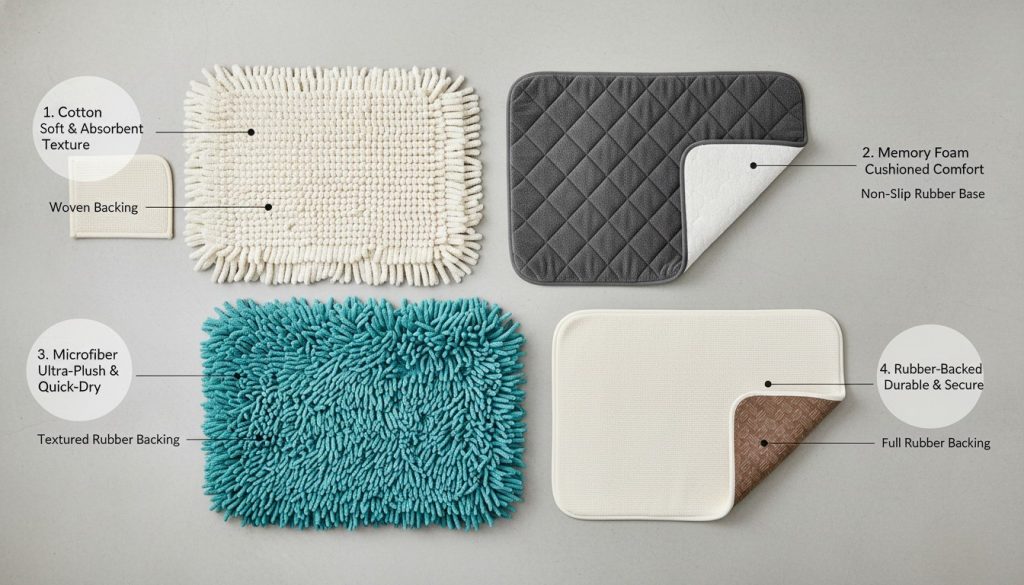
The real magic happens when you match the right bath mat type to the right job. That’s what the rest of this article is all about.
1. Indoor Entryways: Can You Use Bath Mat as Doormat?
This was actually my first bath mat “aha moment,” and it happened purely by accident.
I was tired of my traditional doormat looking perpetually grungy, especially during Chicago’s slushy winter months. One particularly gross February day, I tossed my old doormat in the trash and temporarily laid down a bath mat I’d been meaning to donate. I figured I’d buy a proper replacement that weekend.
That weekend came and went. Three months later, the bath mat was still there because it was working better than any doormat I’d ever owned.
Here’s why it works so well indoors: the absorbency is unmatched. When people track in rain, snow, or mud, a good bath mat soaks it up instead of just smearing it around. The cushioned surface is also noticeably more comfortable underfoot, which sounds trivial until you’re standing there taking off wet boots. Plus, whenever it gets gross, I just toss it in the washing machine—no scrubbing required.
I’ve now used bath mats as indoor doormats for two years across three different entryways in my home. The one by my back door (which gets the most traffic) has held up remarkably well. It’s a cotton bath mat from Target that cost me $12, and it’s still going strong.
But let’s talk about the limitations, because they’re real. I tried using a bath mat as an outdoor doormat once, and it was a disaster. Within two weeks, it looked absolutely trashed. The rubber backing started crumbling from sun exposure, and the fabric portion got that weird, permanent outdoor grime that no amount of washing could fix. Outdoor doormats need to handle UV rays, temperature extremes, and constant exposure to the elements—bath mats just aren’t built for that.
For indoor use as a doormat or area rug, though? Absolutely recommend it. Just stick to low-to-medium traffic areas. I wouldn’t put one in a commercial building’s entrance, but for a home entryway, it’s perfect.
2. The Kitchen Game-Changer: Bath Mats as Kitchen Mats
If you cook regularly and don’t have a cushioned kitchen mat, you’re missing out on one of life’s small luxuries. And if you think those specialized “kitchen mats” are worth the premium price, let me introduce you to a budget-friendly alternative that works just as well.
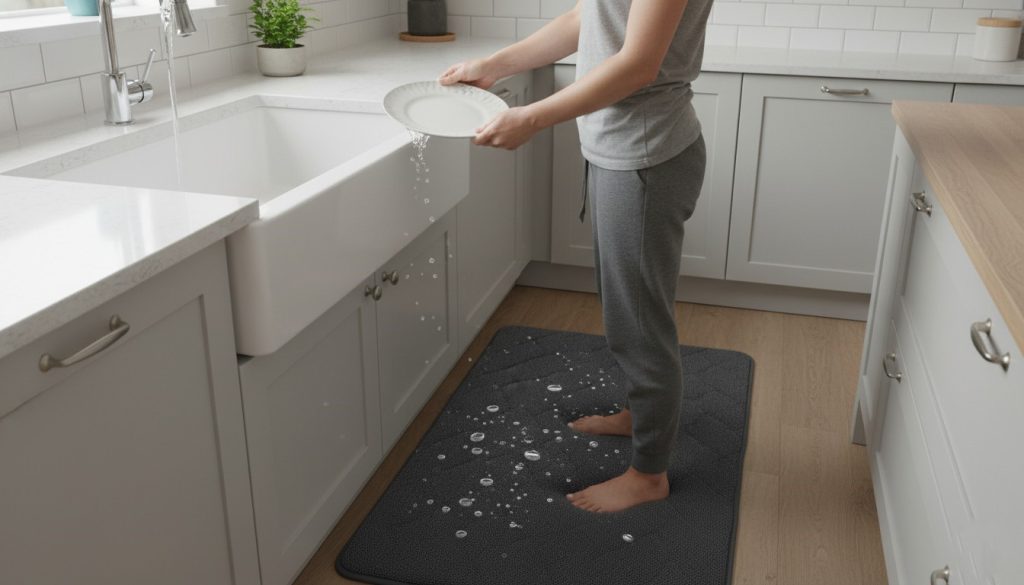
I spend a lot of time in my kitchen. Between meal prep, cooking, and the inevitable cleanup, I’m easily on my feet for an hour or more most evenings. Last year, I developed some heel pain that my doctor attributed partially to standing on hard tile floors. She suggested a cushioned kitchen mat, but the nice ones were running $50-80, which felt excessive.
On a whim, I grabbed a $15 memory foam bath mat instead, and I’m not exaggerating when I say it changed my cooking experience. The cushioning provides genuine anti-fatigue relief, making long cooking sessions noticeably more comfortable. When I inevitably splash water all over while washing dishes, it absorbs everything instead of creating a slippery hazard. And here’s the kicker: it’s actually easier to clean than the specialized kitchen mat my sister owns.
I’ve strategically placed bath mats in three kitchen locations, and each serves a specific purpose. The one in front of my sink is a microfiber version that dries quickly between uses—crucial when you’re dealing with constant water exposure. Near my stove, I use a thinner cotton mat that lies flatter and won’t trip me when I’m moving quickly with hot pans. Under my dog’s food bowls, there’s an old bath mat that catches water splashes and kibble scatter, saving my floor from constant wear.
The only real downside I’ve encountered is that memory foam bath mats can trap food particles in the textured surface if you’re not careful. I learned this the hard way after a particularly enthusiastic vegetable chopping session. Now I shake mine out over the sink daily and wash it weekly.
Pro tip: choose bath mats without decorative elements or raised patterns for kitchen use. A flat, simple surface is much easier to keep clean.
3. Revolutionary Pet Bedding: Bath Mats for Guinea Pig and Rabbit Bedding
This one might sound unusual if you’re not a small pet owner, but stick with me—it’s genuinely brilliant.
My friend Sarah has three guinea pigs, and she was spending about $40 a month on specialized cage liners and bedding. She was constantly frustrated by how quickly they’d get soiled and how expensive it was to maintain a clean, comfortable environment for her pets. When I suggested trying bath mats, she was skeptical but desperate enough to experiment.
Six months later, she’s completely converted to the bath mat system and has cut her bedding costs by more than half.
Here’s how it works: bath mats provide a soft, absorbent surface that’s surprisingly similar to those expensive fleece cage liners marketed specifically for small animals. The key difference? They’re a fraction of the cost. A quality bath mat runs $10-20 and can be cut to size for different cage configurations. Many small pet owners layer them over absorbent pads for maximum effectiveness.
The absorbency factor is crucial for guinea pigs and rabbits, who need clean, dry spaces to prevent health issues. Cotton and microfiber bath mats wick moisture away from the surface, keeping your pet’s feet dry and comfortable. This is especially important for guinea pigs, whose feet are particularly sensitive to prolonged moisture exposure.
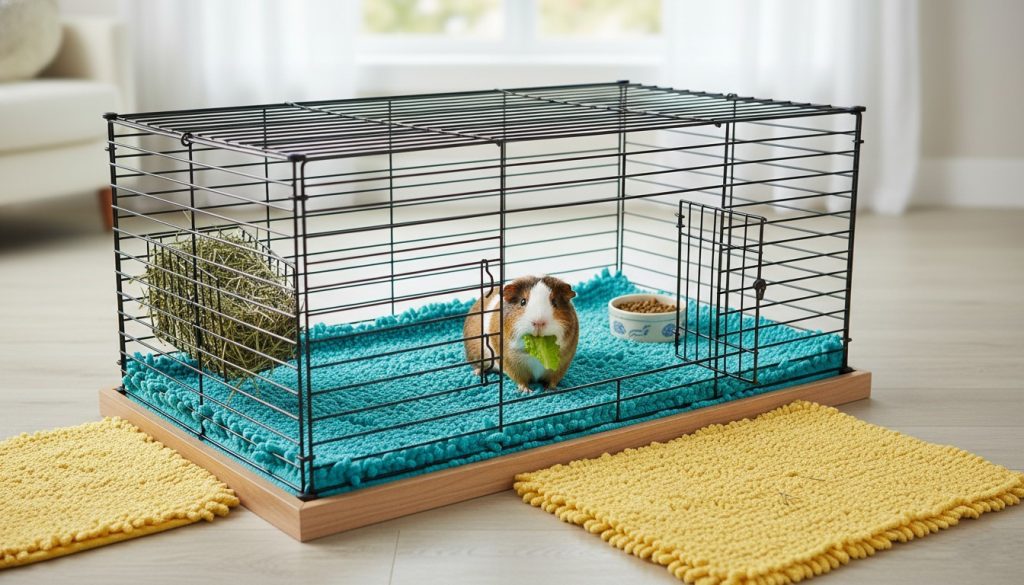
Sarah’s system involves rotating between three bath mats per cage. While one is in use, one is in the wash, and one is the clean backup. She washes them every 3-4 days on hot water with white vinegar added to the rinse cycle, which eliminates odors and keeps them fresh.
But here are the important caveats: not all bath mats work for this purpose. Avoid anything with long loops or loose fibers that could catch on tiny toenails or be ingested. Memory foam versions aren’t ideal because they take too long to dry and can harbor bacteria if they stay damp. Stick with flat-weave cotton or microfiber options.
Also, while bath mats work wonderfully as part of a bedding system, they shouldn’t be the only bedding element. Sarah still uses absorbent pads underneath for heavy wetters, and she provides hay and other enrichment materials on top. Think of the bath mat as the comfortable, washable middle layer that makes maintenance easier—not a complete replacement for a proper small animal habitat setup.
One more thing: some bath mats are treated with chemicals or anti-bacterial agents that aren’t safe for animals who might chew on them. Always wash new mats several times before using them in pet areas, and monitor your pet’s behavior. If they start chewing the mat, it’s not the right solution for your situation.
4. Pool and Tub Drain Applications That Actually Work
I’m going to be honest: this was the application I was most skeptical about when I first heard of it. Using a bath mat for pool or tub drain coverage sounded like one of those “life hacks” that looks good in a TikTok video but fails spectacularly in real life.
Then I housesit for my parents, who have a pool, and ended up testing it myself.
The concept is straightforward: place a bath mat strategically over or near pool drains to catch hair and larger debris before it gets into your filtration system. This isn’t meant to replace actual drain covers or pool filters—those are non-negotiable safety and maintenance equipment. Instead, it’s an extra layer of protection that can extend the life of your pool filter and reduce how often you need to clean it.
During one particularly crowded pool party (eight people, four of them with long hair), I positioned a microfiber bath mat near the pool steps where people entered and exited most frequently. After the party, I was genuinely surprised by how much hair and debris that mat had caught. It wasn’t a perfect solution, but it noticeably reduced the amount of junk that made it to the pool’s main filtration system.
For bathtub applications, the use case is slightly different but equally practical. I’ve used a thin bath mat positioned over my tub drain during the hair-washing phase of my shower. As someone with long, thick hair that sheds like a golden retriever in summer, this simple trick has saved me from several clogged drains. The mat catches the hair, I remove it after showering, and my drain stays clear.
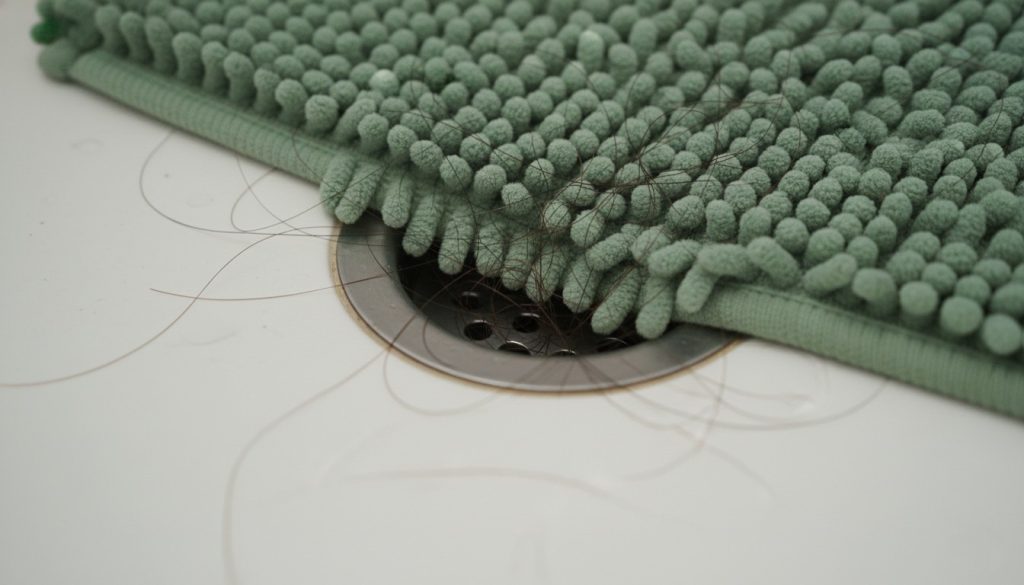
The key to success here is choosing the right type of mat and using it correctly. For pool applications, you want something that dries quickly and resists mildew—microfiber works well. It needs to be secured properly so it doesn’t become a tripping hazard, and you must clean it frequently (I’d say after every pool use or at least every other day).
For tub drains, go thin and flat. Those thick, plush bath mats will just hold water and create a soggy mess. A basic, flat-weave cotton or microfiber mat works perfectly and is easy to rinse and hang-dry after each use.
The biggest limitation is maintenance. If you’re not diligent about cleaning these mats regularly, they’ll become mildew magnets faster than you can say “pool maintenance.” In pool environments especially, you need to thoroughly rinse, wash, and completely dry them between uses, or you’ll end up with a smelly, bacteria-harboring problem.
Also, let me be crystal clear: this is a supplementary approach, not a replacement for proper drain covers and filtration systems. Pool safety requires appropriate drain covers that meet current safety standards. Bath mats are just an additional tool for reducing maintenance hassle.
5. Under Pet Food Bowls: The Mess-Containment Hero
This might seem obvious now that I’ve mentioned it, but it took me three years of pet ownership to figure it out.
My dog Banjo is an enthusiastic but spectacularly messy eater. Water splashes everywhere when he drinks, kibble scatters when he crunches, and somehow food particles migrate up to three feet from his bowls. For years, I kept a small towel under his food station, but I was washing it daily and it never really stayed in place.
One day, I grabbed a small bath mat that was headed for the donation pile and put it under his bowls instead. Life-changing might be too strong a word, but honestly, not by much.
The rubber backing keeps everything firmly in place, even when Banjo enthusiastically nudges his bowls around. The absorbent surface catches water splashes instantly, preventing the puddles that used to form on my hardwood floor. And the cushioning actually protects my floor from the constant impact of metal bowls being pushed around.
I’ve been using the same bath mat for this purpose for over a year now, and it’s held up beautifully despite being washed weekly. I chose a dark-colored one specifically to hide stains, which was a smart move. Even when it gets kibble dust or the occasional splatter of wet food, a quick shake outside and a wipe-down keeps it looking decent between proper washes.
My friend Lisa took this concept even further with her cat feeding station. She has three cats and uses an extra-large bath mat (the kind designed for double-sink bathrooms) to create an entire designated feeding zone. It contains the mess from all three cats and has made her life noticeably easier.
The only consideration here is choosing a machine-washable mat without any decorative elements that could trap food particles. Flat, simple surfaces are your friend. Also, if your pet is a chewer, supervise the first few days to make sure they’re not interested in making the mat their next toy.
6. Garage and Workshop Kneeling Pads
I’m not exactly a hardcore DIY person, but I do enough home maintenance and small projects to have learned this lesson the hard way: kneeling on concrete floors is absolutely brutal on your joints.
Last spring, I spent a weekend painting baseboards throughout my apartment. By the end of day one, my knees were so sore I could barely walk up stairs. That’s when I remembered I had a couple of old memory foam bath mats sitting in my linen closet.
The next day, I folded one in half for extra cushioning and used it as a kneeling pad. The difference was night and day. What had been legitimately painful the day before became merely mildly uncomfortable. I finished the project without further knee damage and gained a permanent addition to my tool arsenal.
Since then, I’ve kept two bath mats in my small workshop area specifically for this purpose. One is folded in half permanently (I even stitched the fold in place) for maximum cushioning when I’m working on low-to-the-ground projects. The other stays flat for when I need to kneel and move along a surface, like when I’m caulking baseboards or organizing low shelves.
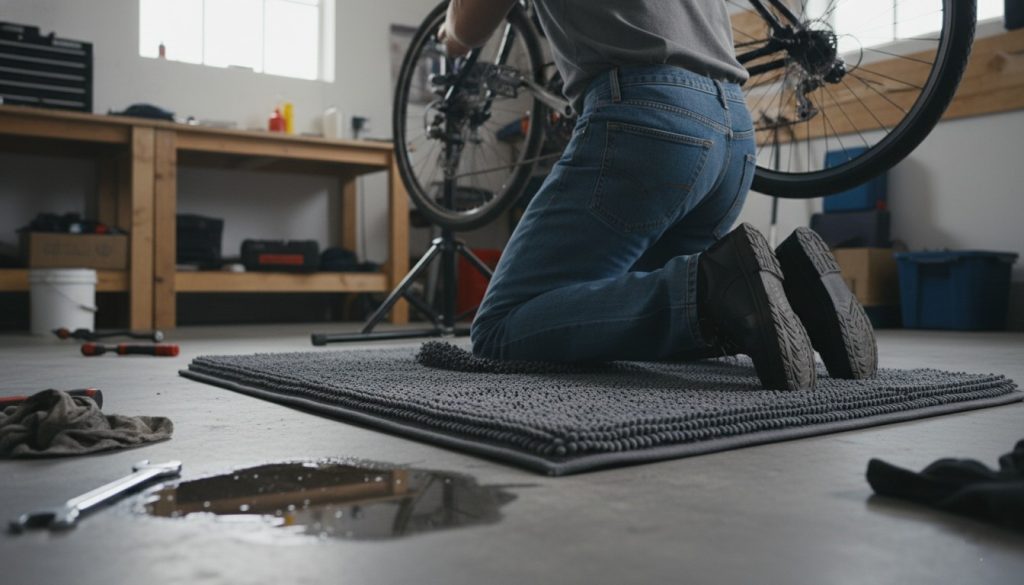
Memory foam bath mats are absolutely the way to go for this application. The cushioning they provide is superior to thin cotton mats, and they hold up well to the kind of abuse workshop environments dish out. Mine have survived paint drips, oil stains, and being dragged across rough concrete hundreds of times.
The portability factor is also huge. Unlike those bulky foam kneeling pads you can buy at hardware stores, bath mats are thin enough to hang on a wall hook or store in a narrow space. I can easily carry mine from room to room as needed, and when they get too dirty, into the washing machine they go.
My dad, who is an actual handy person unlike me, now keeps a bath mat in his car trunk specifically for roadside work or any situation where he needs to kneel or lie down on a surface that’s less than ideal. He’s used it for changing tires, working under his car, and even as a cushioned surface for setting down tools that might otherwise scratch or roll away.
The one limitation is that heavily soiled workshop mats can be tough to fully clean. Once mine pick up oil or certain types of grease, washing helps but doesn’t completely restore them. That’s fine—I consider them workshop-designated at that point and don’t try to rotate them back to bathroom duty.
7. Car Trunk Protection That Actually Makes Sense
This use case came about from pure desperation during a particularly muddy camping trip.
I had just loaded my car with wet, dirty camping gear, and I could practically see my pristine trunk liner crying. I had a bath mat in my overnight bag (long story, but it had something to do with the campground showers being questionable), and I threw it down in the trunk to provide at least some barrier between the mud-caked equipment and my car.
Fast forward to now: I keep a dedicated bath mat in my trunk permanently, and it’s saved my car’s interior countless times.
Here’s why it works brilliantly: bath mats are absorbent enough to handle wet items, protective enough to prevent scratches and scuffs, and cushioned enough to keep items from sliding around quite as much. They’re also infinitely easier to clean than your car’s actual trunk liner. When mine gets dirty, I pull it out, shake it off, and either wipe it down or throw it in the wash. Try doing that with factory trunk carpeting.
I’ve used my trunk bath mat for transporting wet beach gear, muddy shoes, leaking grocery bags, potted plants, and painting supplies. It’s caught everything from beach sand to potting soil to a slow leak from a gallon of milk that would have been a nightmare to clean out of my trunk’s carpet.
My trunk mat is a dark-colored cotton one that cost $10 at HomeGoods. After a year of fairly heavy use, it’s still holding up fine, though it definitely looks well-loved. The rubber backing has kept it from sliding around, which is important for both protecting items and preventing the mat itself from bunching up.
If you frequently transport pets, this becomes even more valuable. My friend Tom uses a bath mat to line the cargo area when he takes his dog to the park or vet. It catches muddy paw prints, absorbs any accidents, and provides his dog with a more comfortable, less slippery surface than the bare plastic trunk liner.
The only real downside is that a single bath mat won’t cover a large trunk area completely. If you’ve got an SUV or wagon, you might need to use two or three mats, or accept that you’ll only get partial coverage. I’ve found that strategic placement—focusing on the areas most likely to get dirty—works better than trying to cover every square inch.
8. Plant Pot Underlays for Indoor Gardening
I came to this realization after ruining my third windowsill with water rings from plant pots.
No matter how careful I was, water would somehow escape from drainage holes or condensation would form on the saucer, creating moisture damage on my wooden surfaces. Traditional plant saucers helped, but water would still overflow or splash out when I watered enthusiastically.
Now I cut bath mats into squares and place them under my plant arrangements. Problem solved.
The absorbency handles any overflow during watering, protecting furniture and floors from water damage. The rubber backing prevents moisture from seeping through to the surface underneath, and it keeps the whole setup from sliding around. Plus, the cushioning provides a slight buffer that prevents heavier pots from leaving indentations on softer surfaces.
I’ve been using this system for about eight months across a dozen plants, and I haven’t had a single water-damage incident since implementing it. My living room plant shelf, which used to show water marks despite my best efforts, now stays pristine.
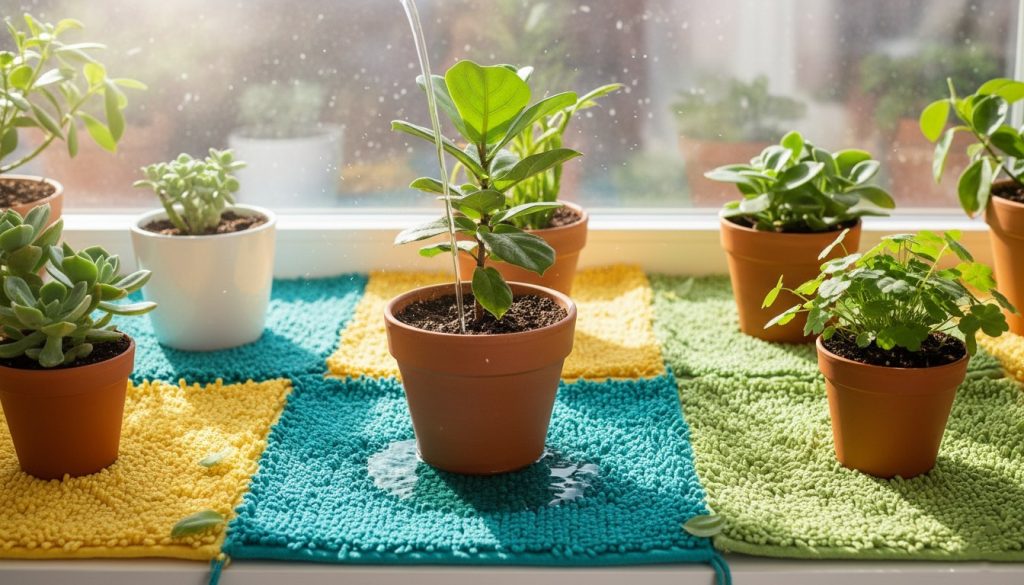
For this application, I cut up old bath mats that were getting worn in some areas but still had plenty of good sections. Cotton mats work best because they’re easiest to cut cleanly and they dry relatively quickly if they get saturated. I use sharp fabric scissors to cut them into squares sized appropriately for each plant or plant grouping.
One unexpected benefit: when I need to move plants for cleaning or rearranging, the bath mat squares stick to the bottom of the pots and move with them thanks to moisture and the slight tackiness of the rubber backing. This means my surfaces stay protected even during plant shuffling.
The main limitation is aesthetics. Let’s be honest: a visible bath mat under your carefully curated plant display isn’t winning any interior design awards. I’ve worked around this by choosing bath mats in neutral colors that blend with my furniture, and by making sure the cut squares are slightly smaller than the pots sitting on them, so they’re less noticeable.
Also, if a mat gets truly soaked during heavy watering, you need to lift the plant and let the mat dry completely. Otherwise, you risk mildew growth, which defeats the whole purpose of protecting your surfaces.
9. Outdoor Furniture Cushioning and Protection
This application came out of a problem I didn’t even know I was looking for a solution to until I accidentally stumbled upon it.
I have a small balcony with a couple of metal folding chairs that are functional but incredibly uncomfortable for sitting longer than about ten minutes. I was constantly dragging out throw pillows from inside, which would get dirty or wet and need constant replacement. One evening, I grabbed a bath mat to sit on because all my pillows were in the wash, and I was pleasantly surprised by how well it worked.
Bath mats provide just enough cushioning to make hard outdoor furniture significantly more comfortable. The rubber backing keeps them from sliding off chairs or benches, which is a constant problem with loose cushions or towels. And unlike fabric cushions, when they get rained on or dirty, they’re designed to handle moisture and dry relatively quickly.
I now keep two bath mats on my balcony permanently. One lives on my chair as a seat cushion, and the other I use as a foot rest or extra seating when friends come over. They’ve handled rain, sun exposure, and general outdoor conditions for about five months now, and while they’re definitely weathering, they’re holding up far better than I expected.
For temporary outdoor seating situations—like picnics, beach outings, or camping—bath mats work even better. They’re more portable than full cushions, they provide a barrier between you and wet or dirty surfaces, and they offer enough padding to make sitting on the ground or hard surfaces much more bearable.
My camping friends have embraced this concept enthusiastically. Several of them now pack a cheap bath mat specifically for creating a comfortable sitting or changing area inside their tents. The cushioning provides insulation from cold ground, the surface is easier to keep clean than bare tent floor, and if it gets too gross, you’re only out ten dollars.
The durability question is real, though. Outdoor use is tough on materials that weren’t specifically designed for constant sun and weather exposure. My balcony mats are definitely fading and the rubber backing is starting to deteriorate where it gets full sun exposure. I expect I’ll need to replace them after a full summer season, but at $10-15 per mat, that’s still way cheaper than outdoor cushions.
Don’t expect these to last multiple years outdoors. Think of them as affordable, seasonal solutions rather than permanent outdoor furniture investments.
10. Litter Box Scatter Control
Cat owners, this one’s for you.
My neighbor Jess has two cats and was constantly battling litter scatter around their boxes. No matter what type of mat she bought specifically for this purpose, litter still migrated across her laundry room floor. Those specialized “litter-trapping” mats were running her $25-40 each, and she needed two of them.
I suggested trying bath mats instead, and she reluctantly agreed, expecting minimal results.
Two months later, she reports that the bath mats work just as well as the expensive specialty mats and are actually easier to clean. The textured surface of most bath mats catches litter particles as cats exit the box, and the size of most bath mats (typically larger than standard litter mats) provides more coverage for litter tracking.
The key is choosing the right texture. Mats with a nubby or textured surface work best because they trap litter granules between the fibers. Smooth microfiber mats are less effective. Jess uses cotton bath mats with a looped texture, and she shakes them out over her trash can every few days, then washes them weekly.
The rubber backing is crucial here too. It prevents the mat from sliding around when cats exit the box with their typical post-bathroom scramble, and it keeps litter from working its way underneath where it’s harder to clean.

One advantage over specialty litter mats: bath mats are much easier to really clean. Jess can throw hers in the washing machine with hot water and detergent, while her old litter mats had specific care instructions and couldn’t be properly washed in a standard machine.
The one consideration for this application is making sure you’re okay dedicating a bath mat permanently to litter duty. This isn’t a mat you’ll want to rotate back to bathroom use. Buy one or two specifically for this purpose, ideally in a color that hides litter dust (beige or gray work well).
Also, if your cat is a particularly enthusiastic litter-kicker, you might need to use multiple bath mats to create a larger coverage area. Jess has two bath mats positioned in an L-shape around the exit side of her litter boxes, which catches significantly more scatter than a single mat would.
11. Laundry Room and Utility Sink Applications
My final bath mat hack happened to address one of my most annoying household problems: the constant puddles in front of my utility sink.
I use my laundry room sink constantly—for hand-washing delicates, rinsing muddy shoes, cleaning paint brushes, and all manner of messy tasks. Despite my best efforts, water always ended up on the floor. I tried various solutions, but nothing really worked until I put a memory foam bath mat in front of the sink.
The absorbency handles splashes instantly, the cushioning makes standing at the sink much more comfortable (especially during longer tasks like hand-washing sweaters), and the rubber backing keeps it perfectly positioned despite the high-traffic nature of a laundry room.
This has been my longest-running bath mat experiment—the same mat has been in front of my utility sink for over 18 months now. It gets washed every couple of weeks and has held up remarkably well considering the amount of abuse it takes. I’ve splashed everything from bleach solution to mud water on it, and it always washes clean.
The utility room application extends beyond just sink areas, though. I’ve also positioned a bath mat in front of my washer and dryer to catch detergent drips and provide cushioning while I’m transferring loads. The small amount of padding makes a surprising difference when you’re doing multiple loads and constantly bending down to empty the dryer.
For anyone with an unfinished basement or utility area with concrete floors, bath mats provide an affordable way to create more comfortable standing zones in high-use areas. They’re not a replacement for proper floor coverings, but they’re perfect for those in-between spaces where you need function over form.
Choosing the Right Bath Mat for Repurposing
After two years of bath mat experimentation, I’ve learned that not all bath mats are created equal when it comes to alternative uses.
For absorbency-focused applications (entryways, kitchen, pet bowls), cotton is your best bet. It washes well, gets softer over time, and handles moisture effectively. I’ve had the best luck with basic cotton mats from Target or Amazon Basics—nothing fancy, typically in the $10-15 range.
For comfort applications (kitchen standing, workshop kneeling, outdoor seating), memory foam is unmatched. Yes, it takes longer to dry and costs a bit more ($20-30), but the cushioning is worth it. My memory foam kitchen mat has probably saved me from hours of foot and back pain.
For quick-drying needs (pool areas, bathroom drains, anything outdoors), microfiber is the winner. It’s also the most durable option I’ve found for high-wear applications. These typically run $12-20.
Size matters too. Standard bath mats are usually 17×24 or 20×30 inches, which works for most applications. For larger coverage needs (like car trunks or pet feeding stations), look for the larger sizes designed for double-sink bathrooms. These run bigger (24×40 inches or more) and provide much better coverage.
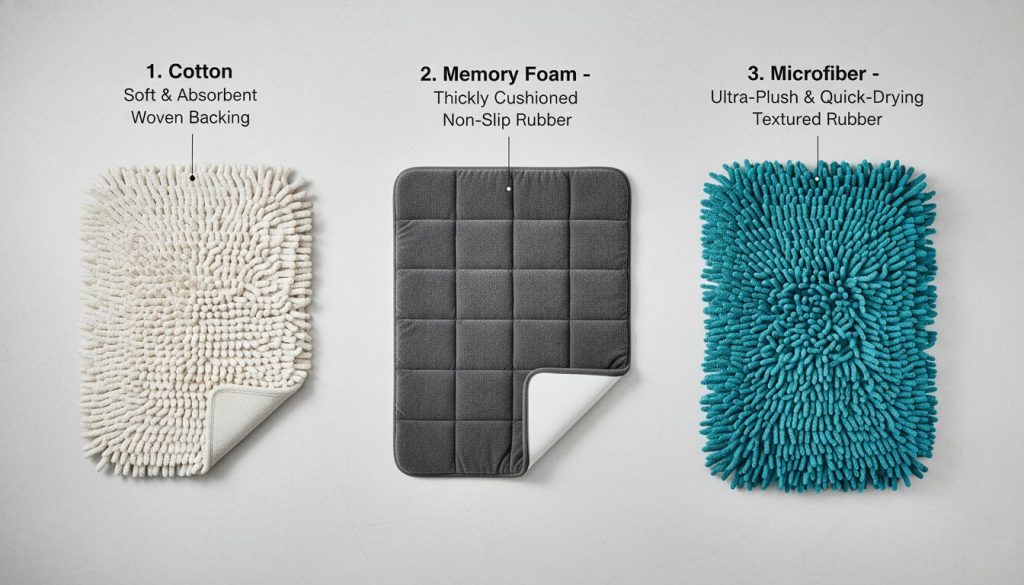
Don’t overlook discount stores and clearance sections. Since you’re not relying on these mats to be decorative bathroom pieces, mismatched colors or slightly imperfect items work perfectly fine. I’ve found great deals at HomeGoods, TJ Maxx, and Target’s clearance endcaps. Buying multiples when they’re on sale means you’ve always got a mat ready for your next project or need.
One final tip: keep your bathroom mats and repurposed mats clearly separate. I use a laundry marker to put a small X on the corner of any mat that’s been designated for non-bathroom use. This prevents the awkward situation of accidentally rotating a workshop mat back into bathroom service.
The Bottom Line: Why Bath Mats Are Seriously Underrated
Look, I know writing 3,000 words about bath mats makes me sound a little obsessed. But here’s the thing: once you start seeing these versatile textiles as multipurpose household tools rather than single-function bathroom items, a whole world of practical possibilities opens up.
In the past two years, repurposing bath mats has saved me several hundred dollars compared to buying specialized items for each application. A litter mat, anti-fatigue kitchen mat, workshop kneeling pad, trunk liner, and pet feeding station mat would have easily cost me $150-200 if I’d bought purpose-made products. Instead, I’ve spent about $60 on bath mats that serve all these functions.
Beyond the money savings, there’s something satisfying about finding creative solutions to everyday problems using items you already have or can easily acquire. It’s environmentally friendlier to repurpose old bath mats than to buy new specialized products. And when something designed for one purpose works brilliantly for another, it feels like you’ve cracked a life code that everyone else is missing.
The versatility comes down to that simple combination: absorbency, cushioning, and a non-slip backing. Those three features solve a surprising number of household challenges. Whether you’re trying to keep your kitchen floor dry, protect your pet’s delicate feet, or just make your concrete garage floor less punishing on your knees, there’s probably a bath mat solution.
Start small if this all seems overwhelming. Next time you’re about to toss an old bath mat, try it under your pet’s food bowls or in your car trunk. See how it works. Once you experience the utility firsthand, you’ll start spotting opportunities everywhere.
Just don’t blame me when you become that person buying extra bath mats at every trip to Target. Trust me, your friends might laugh now, but they’ll be asking for your creative life hack secrets soon enough.
Leave a Reply